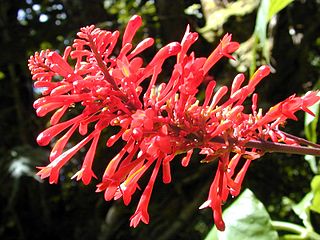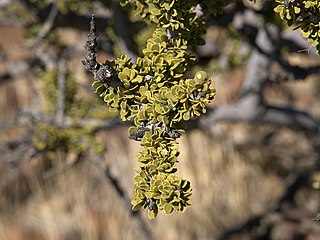
Acanthaceae is a family of dicotyledonous flowering plants containing almost 250 genera and about 2500 species. Most are tropical herbs, shrubs, or twining vines; some are epiphytes. Only a few species are distributed in temperate regions. The four main centres of distribution are Indonesia and Malaysia, Africa, Brazil, and Central America. Representatives of the family can be found in nearly every habitat, including dense or open forests, scrublands, wet fields and valleys, sea coast and marine areas, swamps, and mangrove forests.

Boswellia is a genus of trees in the order Sapindales, known for its fragrant resin. The biblical incense frankincense is an extract from the resin of the tree Boswellia sacra, and is now produced also from B. frereana.

The genus of the myrrhs, Commiphora, is the most species-rich genus of flowering plants in the frankincense and myrrh family, Burseraceae. The genus contains approximately 190 species of shrubs and trees, which are distributed throughout the (sub-) tropical regions of Africa, the western Indian Ocean islands, the Arabian Peninsula, India, and Vietnam. The genus is drought-tolerant and common throughout the xerophytic scrub, seasonally dry tropical forests, and woodlands of these regions.

Hypoestes is a flowering plant genus of about 150 species. They are widely distributed throughout the tropical and subtropical lands around the Indian Ocean, and some adjacent regions.

Aneilema is a genus of monocotyledonous plants of approximately 60 species. The vast majority of the species are native to sub-Saharan Africa, but a few are found in Oceania and one, Aneilema brasiliense, is from South America. It is the third largest genus in the family Commelinaceae after Commelina and Tradescantia, and it is one of only six genera in the family to occur in both the Eastern Hemisphere and the Western Hemisphere.

Boscia is a genus of plant in family Capparaceae. It contains the following species:

Faurea is a genus containing 15 species of flowering plants in the protea family which occur in the summer rainfall area of southern Africa, extending to tropical Africa and Madagascar. The name honours South African soldier and botanist William Caldwell Faure (1822-1844) who was killed on active service in India.

Mimulopsis is a genus in the flowering plant family Acanthaceae with about 30 species native to tropical Africa and Madagascar.
Emilio Chiovenda was an Italian botanist.

Perotis is a genus of Asian, African, and Australian plants in the grass family.
Pseudozoysia is a genus of plants in the grass family. The only known species is Pseudozoysia sessilis, found only in Somalia.

Arundinella is a widespread genus of plants in the grass family, common in many tropical and subtropical regions.
Coelachyrum is a genus of Asian and African plants in the grass family.

Schizachyrium is a widespread genus of plants in the grass family. The name is derived from the Ancient Greek words σχίζειν, meaning "to split," and ἄχυρον, meaning "chaff." It refers to either the glume or the toothed lemmas.

Tristachya is a genus of African and Latin American plants in tribe Tristachyideae within the grass family.
Trichopteryx is the scientific name of two genera of organisms and may refer to:

Crabbea is a genus of flowering plants native to eastern and southern Africa. They are generally low-growing perennial herbs. The five-petaled flowers are surrounded by prickly bracts.
Whitesloanea is a genus of flowering plants belonging to the family Apocynaceae. It has an unusual odor, in that many believe it to smell of fecal matter. Some have postulated that the center of the flower is actually meant to mimic an anal cavity.












